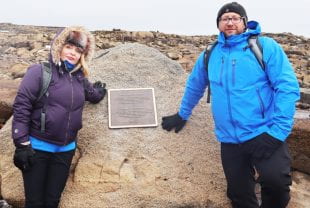After a chilly two-hour hike up rocky terrain on an Icelandic shield volcano, Rice anthropologists Cymene Howe and Dominic Boyer joined nearly 100 others to say a final farewell to Okjökull, Iceland’s first named glacier lost to climate change.

Cymene Howe and Dominic Boyer
The unveiling of a monument on the site of the former glacier was a symbolic gesture, but it attracted political and media attention from around the world. Immediately before their hike, Icelandic Prime Minister Katrín Jakobsdóttir and Mary Robinson, former president of Ireland and United Nations High Commissioner for Human Rights, offered solemn remarks and ominous warnings.
“We see the consequences of the climate crisis,” Jakobsdóttir said. “We have no time to lose.”
The two Rice anthropologists traveled to Iceland for the Aug. 18 ceremony because they were responsible for the work that led to the memorial. Howe is the principal investigator for the project “Melt: The Social Life of Ice at the Top of the World,” which she conducted with Boyer, examining the cultural impacts of climate change. Howe and Boyer also produced the 2018 documentary “Not Ok,” which warned that scientists fear all of Iceland’s 400-plus glaciers will be gone by the turn of the next century.
During the ceremony, Howe talked about the importance of creating a lasting reminder of the lost glacier.
“So often when we’re talking about global warming and climate change, it’s often abstract,” she said. “A memorial, however, is an emotional act and a physical symbol of the losses we are seeing. Everywhere in the world people recognize the power of memorials. This one is to show how dramatically our natural world is changing.”
The event also included speeches from Icelandic Minister for the Environment and Natural Resources Guðmundur Ingi Guðbrandsson, Boyer, author Andri Snær Magnason (who wrote the words for the memorial plaque) and geologist Oddur Sigurðsson, in addition to a special poem about Okjökull authored and read by Gunnhildur Hallgrímsdóttir.
After the speeches, children attending the event helped formally install the monument.
“We felt it was important to have the children install the plaque because the message of this memorial is that we are accountable to future generations,” Boyer said. “The quality of their lives will depend on the climate actions we take, or don’t take, today. As adults, we need to always be thinking about how our children and grandchildren will judge us.”
Although the monument is located in a remote spot, Howe and Boyer hope the international interest drawn by the memorial ceremony will raise awareness about the decline of Iceland’s glaciers and the impact of climate change.
“This memorial is not only about recognizing a loss,” Howe said. “It is a call to action, not more empty promises. The children pushed the memorial plaque into the stone because it is their destiny that we, and they, need to cement into place for a better future.”


